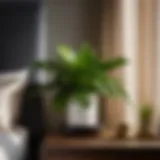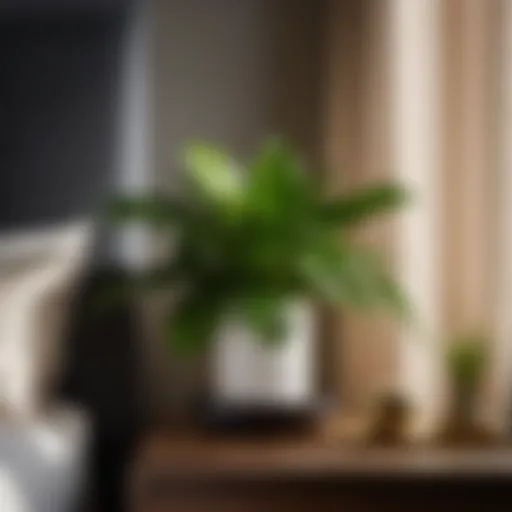Ultimate Guide to Mold Removal from Bathroom Walls: Effective Strategies Revealed


Materials:
- Bleach: 1 gallon
- Water: 1 cup
- Protective gear: gloves, mask, goggles
- Scrub brush
- Spray bottle
- Vinegar: 1 cup
DIY Steps:
- Put on protective gear, including gloves, mask, and goggles.
- Mix 1 cup of bleach with 1 gallon of water in a spray bottle.
- Spray the bleach solution onto the mold-affected areas of the bathroom walls.
- Let the solution sit for 15 minutes to effectively kill the mold.
- Scrub the walls with a scrub brush to remove the mold stains.
- Rinse the walls thoroughly with water.
- Mix 1 cup of vinegar with water in a spray bottle.
- Spray the vinegar solution on the walls to inhibit future mold growth.
Technical Aspects:
- Tools: Protective gear, scrub brush, spray bottle
- Timing: 15 minutes for bleach solution to sit
- Critical Techniques: Thorough scrubbing, proper ventilation
DIY Project Process:
- Gather all materials and put on protective gear.
- Mix the bleach solution and spray it on the mold.
- Allow the solution to sit for 15 minutes before scrubbing.
- Rinse the walls thoroughly with water.
- Apply the vinegar solution to prevent future mold growth.
- Ventilate the bathroom well to ensure proper drying.
Troubleshooting Tips:
- If mold persists, repeat the process and scrub more vigorously.
- Ensure proper ventilation to prevent mold reoccurrence.
- Seek professional help if mold growth is extensive or recurring.
Understanding Mold Growth in Bathroom Walls
When it comes to the maintenance of our homes, understanding mold growth in bathroom walls is crucial. Mold is not just a cosmetic issue; it can also pose health risks and indicate underlying problems with ventilation and humidity control. By comprehensively examining the causes, health risks associated, and signs of mold growth in bathroom walls, homeowners can take proactive measures to address this issue effectively.
Causes of Mold Growth
Poor ventilation
Poor ventilation in bathrooms can create a breeding ground for mold. The lack of proper airflow allows moisture to accumulate, promoting mold spores' growth and proliferation. Adequate ventilation through exhaust fans and open windows is essential to prevent mold formation and maintain a healthy indoor environment.
High humidity levels
High humidity levels in bathrooms result from activities like showering and bathing, contributing to excess moisture that fosters mold growth. Installing a dehumidifier and promptly repairing any leaks can help regulate humidity levels and inhibit mold development in bathroom walls.
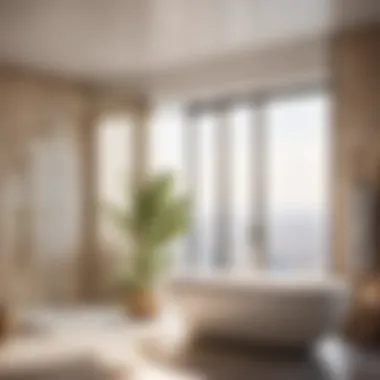

Leaky pipes or fixtures
Leaky pipes or fixtures provide a continuous source of moisture, fueling mold growth behind walls and under sinks. Identifying and repairing leaks promptly is vital to prevent mold from spreading and causing structural damage. Regular plumbing maintenance can help mitigate the risk of mold infestation and safeguard the integrity of bathroom walls.
Health Risks of Mold Exposure
Respiratory issues
Exposure to mold spores can trigger respiratory problems, leading to coughing, wheezing, and exacerbating asthma symptoms. Individuals with compromised immune systems are particularly susceptible to respiratory issues resulting from mold exposure. Removing mold growth from bathroom walls is essential to improve indoor air quality and protect respiratory health.
Allergic reactions
Mold exposure can induce allergic reactions in sensitive individuals, causing symptoms like sneezing, nasal congestion, and skin rashes. Those with allergies or respiratory conditions may experience heightened sensitivity to mold spores, necessitating thorough eradication of mold in bathrooms to prevent allergic reactions.
Irritation of the skin, eyes, and throat
Contact with mold or its spores can irritate the skin, eyes, and throat, leading to redness, itching, and discomfort. Mold-related skin irritation and eye irritation may persist until the underlying mold problem is addressed and the affected areas are thoroughly cleaned. Prioritizing personal protective equipment and proper cleaning protocols is essential to minimize skin, eye, and throat irritation caused by mold exposure.
Identifying Mold on Bathroom Walls
Visible black or green patches
Visible black or green patches on bathroom walls are telltale signs of mold infestation. These patches may appear fuzzy or slimy and emit a musty odor, indicating active mold growth. Promptly identifying and addressing these visible mold patches is critical to preventing further damage and ensuring a hygienic bathroom environment.
Musty or earthy odor
A musty or earthy odor in the bathroom is a common indicator of hidden mold growth behind walls or under floors. This distinctive smell results from mold producing volatile organic compounds (VOCs) that permeate indoor air. Addressing the source of the musty odor and conducting thorough mold inspections are essential steps in identifying and eliminating hidden mold colonies.
Peeling or discolored paint
Peeling or discolored paint on bathroom walls can signify moisture infiltration and mold growth beneath the surface. The presence of mold can compromise the integrity of painted surfaces, causing paint to bubble, crack, or discolor. Inspection of peeling or discolored paint areas is crucial to uncover potential mold colonization and prevent further deterioration of the wall surfaces.
Preventive Measures to Avoid Mold Growth
Mold prevention is crucial in maintaining a clean and healthy bathroom environment. By implementing preventive measures, you can effectively inhibit mold growth and safeguard your walls from the unsightly and harmful effects of mold. Proper ventilation, controlling humidity levels, and establishing a regular cleaning routine are essential components of mold prevention in bathrooms.
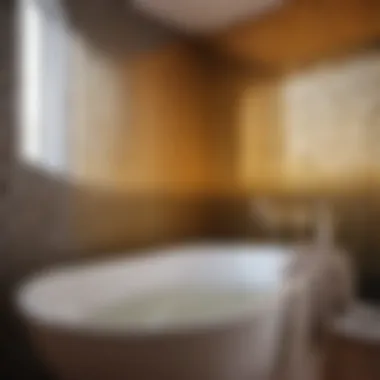

Proper Ventilation
Proper ventilation plays a significant role in preventing mold growth in bathrooms. Use exhaust fans are a critical component of ensuring adequate air circulation. They help to expel humid air, reducing moisture levels that mold thrives on. One key characteristic of exhaust fans is their ability to remove excess moisture efficiently, making them a popular choice for mold prevention. Open windows for air circulation also promote ventilation by allowing fresh air to flow in and stale air to escape. This natural airflow helps in drying out surfaces and reducing humidity levels. While open windows are beneficial for ventilation, they may not be as effective in humid climates where consistent air circulation is necessary.
Controlling Humidity Levels
Use a dehumidifier is a notable method for controlling humidity levels in bathrooms. Dehumidifiers extract moisture from the air, maintaining optimal humidity levels that discourage mold growth. Their key characteristic lies in their ability to regulate humidity effectively, making them a popular choice for mold prevention. However, it's essential to empty the collected water regularly to prevent mold issues within the dehumidifier. Repairing any leaks promptly is crucial in preventing moisture buildup that fosters mold growth. Timely repair of leaks in plumbing fixtures or walls can prevent water accumulation, reducing the risk of mold formation. A key characteristic of prompt leak repair is its immediate action to address potential water sources, which is beneficial for maintaining a mold-free environment.
Regular Cleaning Routine
Using mold-resistant paint is a proactive measure in preventing mold growth on bathroom walls. This specialized paint contains antimicrobial properties that inhibit mold formation, providing long-term protection. The key characteristic of mold-resistant paint is its ability to create a hostile environment for mold spores, making it a popular choice for mold prevention. Cleaning bathroom surfaces regularly helps to remove dirt, grime, and potential mold spores from accumulating. By implementing a consistent cleaning routine, you can minimize the risk of mold development and ensure a hygienic bathroom environment. The key characteristic of regular cleaning is its preventive nature, maintaining cleanliness to deter mold growth.
Removing Mold from Bathroom Walls
Mold removal from bathroom walls is a crucial aspect of maintaining a clean and healthy home environment. Mold growth in bathrooms is a common issue that can not only be unsightly but also pose health risks to individuals. Addressing mold growth promptly and effectively is key to preventing its spread and protecting the well-being of occupants. By following the comprehensive guide provided in this article, you will gain valuable insights into the necessary steps and precautions required to eliminate mold from bathroom walls successfully, ensuring a mold-free and safe living space.
Safety Precautions
Wear Protective Gear
When tackling mold removal, prioritizing safety precautions is paramount to safeguarding your health. Wearing protective gear, such as gloves, goggles, and a mask, is essential to prevent direct contact with mold spores and mycotoxins, which can cause allergic reactions and respiratory issues. Protective gear acts as a barrier between you and potentially harmful mold particles, reducing the risk of exposure and ensuring a safe remediation process.
Ensure Proper Ventilation
Effective ventilation plays a crucial role in mold removal efforts by promoting air circulation and reducing moisture levels in the bathroom. Proper ventilation, through the use of exhaust fans or open windows, helps prevent the buildup of humidity, creating an environment inhospitable to mold growth. Adequate airflow also aids in expelling mold spores released during cleaning, further minimizing exposure risks and enhancing the efficiency of the remediation process.
Cleaning Supplies and Methods
Vinegar or Hydrogen Peroxide Solution
Utilizing natural cleaning agents like vinegar or hydrogen peroxide offers a safe and environmentally friendly approach to tackling mold on bathroom walls. These solutions are effective at killing mold spores and removing surface mold, without the use of harsh chemicals that may pose risks to your health or the environment. Their antimicrobial properties make them potent allies in combating mold growth, while also being budget-friendly and readily available for use.
Scrubbing with a Brush or Sponge
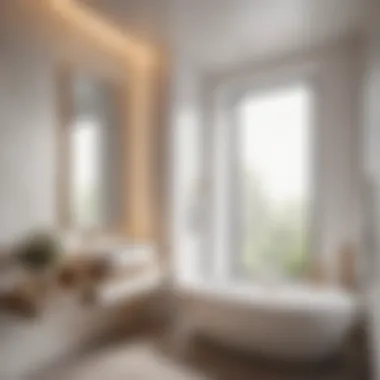

Mechanical removal of mold growth through scrubbing with a brush or sponge is a manual, yet effective method to dislodge mold from bathroom surfaces. The physical action of scrubbing helps loosen and lift mold from porous materials like grout or textured surfaces, allowing the cleaning solution to penetrate deeper for thorough removal. Brushing or sponge cleaning targets visible mold patches and aids in restoring the cleanliness and appearance of affected areas.
Drying the Area Thoroughly
After cleaning, ensuring the bathroom wall is thoroughly dried is crucial in preventing mold regrowth. Moisture is a primary factor contributing to mold growth, thus eliminating excess moisture from the cleaned surfaces hinders mold spores' ability to reestablish colonies. Proper drying techniques, such as using fans or dehumidifiers, promote swift evaporation of residual moisture, creating an inhospitable environment for mold to thrive and effectively hindering its resurgence.
Preventing Mold Regrowth
Fixing Underlying Moisture Issues
Addressing underlying moisture issues, such as leaks or condensation, is fundamental in preventing mold regrowth on bathroom walls. Identifying and rectifying sources of excessive moisture eliminates the favorable conditions that enable mold to proliferate. By fixing these underlying issues promptly, you not only prevent future mold outbreaks but also contribute to maintaining a structurally sound and healthy bathroom environment.
Regular Inspections for Mold Recurrence
Conducting regular inspections for mold recurrence is a proactive measure to ensure early detection and intervention against potential mold regrowth. By regularly checking the bathroom walls for any signs of mold resurgence, such as discoloration or musty odors, you can address emerging mold colonies promptly before they spread and become more extensive. These inspections serve as preventive maintenance, allowing you to stay ahead of mold growth and uphold a mold-free living space for the long term.
Professional Assistance and Further Steps
When it comes to tackling mold growth in your bathroom walls, seeking professional assistance and taking further steps beyond DIY solutions can be crucial to ensuring a thorough and lasting remediation process. Professional assistance offers specialized expertise and resources that can address mold issues effectively and efficiently, giving homeowners peace of mind.
Consulting Mold Remediation Experts
Assessment of Mold Damage
In the realm of mold remediation, the assessment of mold damage plays a pivotal role in gauging the extent of infestation and determining the most appropriate course of action. Mold remediation experts conduct a thorough inspection to identify the source of mold growth, assess the level of contamination, and devise a tailored remediation plan. This step is essential in ensuring that all affected areas are identified and treated adequately, preventing further spread of mold spores. By employing advanced techniques such as air sampling and surface testing, professionals can provide accurate assessments that guide the remediation process effectively. While the assessment of mold damage may incur additional costs, its detailed findings significantly impact the success of mold removal efforts, making it a worthwhile investment for comprehensive remediation strategies.
Professional Remediation Services
Engaging professional remediation services offers homeowners a comprehensive solution to mold infestations, encompassing expert guidance, specialized equipment, and thorough remediation procedures. Professional remediation services involve skilled technicians who are trained in industry best practices and adhere to stringent guidelines for safe and efficient mold removal. These experts utilize advanced technologies such as HEPA filtration systems, antimicrobial treatments, and containment barriers to ensure thorough mold eradication while minimizing cross-contamination risks. By delegating the remediation process to professionals, homeowners can save time and effort while obtaining lasting results that prioritize health and safety. Although seeking professional services may involve higher costs compared to DIY methods, the benefits of swift, effective mold removal and reduced health risks outweigh the initial investment, showcasing the value of professional expertise in mold remediation endeavors.
Seeking Long-Term Solutions
After addressing immediate mold issues, focusing on seeking long-term solutions is key to preventing future infestations and maintaining a mold-free environment in your bathroom. Long-term solutions encompass structural improvements and ventilation enhancements to fortify your bathroom against mold reoccurrence, ensuring a healthy indoor environment for years to come.
Addressing Structural Issues
Addressing structural issues involves identifying and rectifying underlying factors that contribute to mold growth, such as water leaks, inadequate insulation, or poor ventilation. By addressing these structural deficiencies, homeowners can eliminate conducive conditions for mold development and enhance the resilience of bathroom surfaces against moisture infiltration. Structural repairs may include fixing damaged grout, sealing cracks in walls or ceilings, and improving waterproofing measures to create a moisture-resistant barrier that deters mold formation. By prioritizing structural integrity, homeowners can prevent mold from taking root and uphold the longevity of their bathroom interiors.
Implementing Proper Ventilation Systems
A fundamental aspect of long-term mold prevention is implementing proper ventilation systems that promote air circulation and moisture control within the bathroom environment. Proper ventilation systems, such as exhaust fans, ceiling vents, or dehumidifiers, help expel excess humidity from the air, preventing condensation buildup on surfaces that fosters mold growth. By enhancing ventilation, homeowners can combat damp conditions that fuel mold proliferation and create a drier, healthier atmosphere in the bathroom. Implementing ventilation systems also aids in reducing musty odors, improving indoor air quality, and preserving the structural integrity of the bathroom. Embracing proactive measures to enhance ventilation cultivates a hostile environment for mold spores, safeguarding your home against recurring mold issues in the long run.




